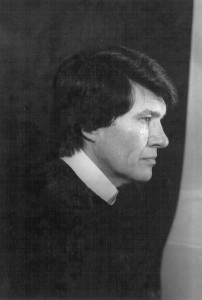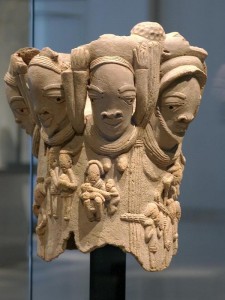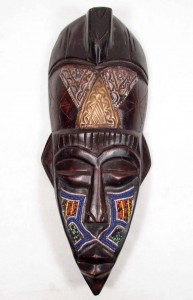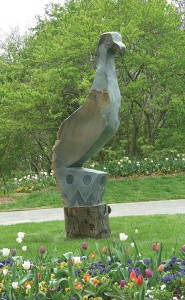
October is one of my favorite months. We are in the season of the “thinned veil” in Celtic tradition, of crisper air, of turning leaves, and of masked goblins. Masks have long been associated with festive holidays such as Halloween and Mardi Gras, the times when it is considered ok to wear a mask, whether literal or figurative. Masks can serve many purposes. We wear masks to impersonate characters. Sometimes the mask will serve as a disguise, or to hide our true features. The mask can also be an essential part of ritual ceremony. From the earliest times, cultures have used masks as an integral part of their culture. Where did this concept originate? In order to explore it, we can turn our attention to the tribal art of Africa as one important source for the development of the mask.

African tribal art was in use long before recorded history. Cave drawings from the Sahara region in Niger date back some 6,000 years. The earliest extant sculptures come from the Nok culture of Nigeria and date c. 500 B.C.E. Traditional tribal art can be generally classified into three major categories.

As a point of reference, let’s look at the tribal art of two regions in Africa—Kenya and Zimbabwe. Both cultures produce masks, sculptures and decorative clothing. Their methods differ, however, and show the enormous change in style since the days of British colonization.
Kenya is especially known for its sculptures. The Kamba Tribe is credited with producing some of the best wood carvers in Africa. Both animals and ritual masks feature prominently in their work. Small figurines are readily available for sale in even the remotest outpost. Like the decorative beading seen on Kenyan clothing, the masks and sculptures are status symbols, adorning the homes and bodies of the prominent tribal members. The Gusii and Abagusii Tribes of Kenya are famous for their soapstone sculptures.
Soapstone (or Kisii stone) is a metamorphic rock, one that has undergone both physical and chemical change through heat and pressure over time. Soapstone is largely composed of talc, and thus is rich in magnesium. It has been a medium of carving for thousands of years. The Palace of Knossos on Minoan Crete contained soapstone on its outer layers, as does the Cristo Redentor of Rio de Janiero. Soapstone is quarried from the Kenyan hills around Tabaka. It comes in colors varying from white (the easiest to carve), through shades of pink, to a deep red (the most difficult to carve).

Since their independence, Zimbabwean artists have experienced a renaissance in the establishment of the Shona Sculptural Movement. This modern-day guild produces much of the “traditional” art, which is not traditional at all, but simply having traditional subjects. One of the most popular is the Ukama figure, Shona, for family. Figurines of parents and children in various combinations are easily available and can be cheaply acquired.
The same can be said for much contemporary African art. It is only traditional in that it uses traditional subject matter and appeals to the tourist trade. Authorities on African tribal art claim that it lost its spiritual power with the coming of Christianity. Late 19th- and early 20th-century missionaries often demanded that articles such as masks, sculptures, etc, be destroyed because of their association with pagan ritual and their supposed powers. Too bad, because we could use “powers” from somewhere these days!
About the only genuine African tribal art available today is that which is made and manufactured for the tourist trade. You can easily pick up a ceremonial mask at any souvenir shop in Nairobi, just don’t expect it to have belonged to some warrior come on hard times!









